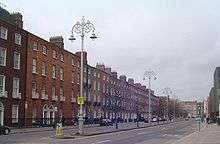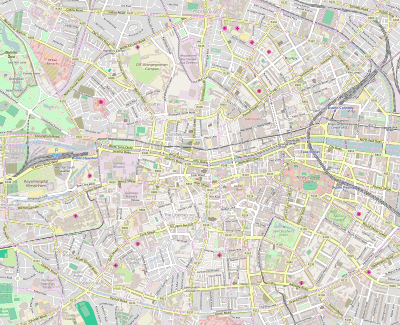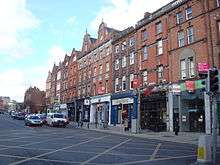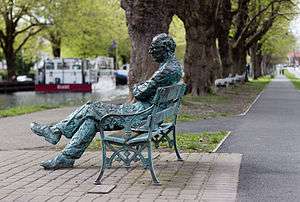Baggot Street
Baggot Street (Irish: Sráid Bhagóid) is a street in Dublin, Ireland. It is named after Baggotrath, the manor granted to Robert Bagod in the 13th century. He built Baggotrath Castle, which was partly destroyed during the Battle of Rathmines and demolished in the early nineteenth century. The street was called Baggot Street in 1773.[1]
 Lower Baggot Street | |
 | |
| Native name | Sráid Bhagóid (Irish) |
|---|---|
| Namesake | Baggotrath, named in turn after Robert Bagod |
| Length | 700 m (2,300 ft) |
| Width | 27 metres (89 ft) |
| Postal code | D02 |
| Coordinates | 53°19′58″N 6°14′32″W |
| northwest end | Merrion Street, Ely Place, Merrion Row |
| southeast end | Grand Canal, Herbert Place, Wilton Terrace |
| Other | |
| Known for | Georgian architecture, Victorian architecture |
Location
The street runs from Merrion Row (near St. Stephen's Green) to the northwestern end of Pembroke Road. It crosses the Grand Canal near Haddington Road. It is divided into two sections:
- Lower Baggot Street (Irish: Sráid Bhagóid Íochtarach) - between Merrion Row and the Grand Canal. It was called Gallows Road in the 18th century.[1]
- Upper Baggot Street (Irish: Sráid Bhagóid Uachtarach) - south of the Grand Canal until the junction with Eastmoreland Place, where it continues as Pembroke Road.
Lower Baggot Street is distinguished by Georgian architecture, while Upper Baggot Street has mainly Victorian architecture with a few buildings of 20th century vintage. The Royal City of Dublin Hospital, opened in 1834, is on the east side of Upper Baggot Street, just south of the junction with Haddington Road.[2] Cook's Map of 1836 shows the north side of Upper Baggot Street and Pembroke Road almost entirely built on.[2]


People
- Darkey Kelly, murderess, executed by burning on Gallows Road (modern Baggot Street) in 1761.[3][4]
- The Sheares Brothers, members of the Society of United Irishmen, who died in the 1798 rebellion, lived at no. 128.[1]
- In 1830, Thomas Davis, the revolutionary Irish writer who was the chief organizer and poet of the Young Ireland movement, lived at 67 Lower Baggot Street.[1]
- Catherine McAuley, a nun, founded the Sisters of Mercy order in 1831 and built what is now the Mercy International Centre on Lower Baggot Street where she later died in 1841.
- In 1909, Francis Bacon was born at 63 Lower Baggot Street.
- The poet Patrick Kavanagh frequented Baggot Street and regarded it as his favourite place in Dublin.
- In his poem "If ever you go to Dublin Town" Kavanagh addresses Dubliners 100 years after his own time and tells them to "Inquire for me in Baggot Street/And what I was like to know". [5]
- Singer-songwriter Sinéad O'Connor has a property here.
 Francis Bacon's birthplace at 63 Baggot Street Dublin
Francis Bacon's birthplace at 63 Baggot Street Dublin
References
- Carol and Jonathan Bardon: If Ever You Go To Dublin Town, Blackstaff Press, 1988 ISBN 0-85640-397-0
- M. Donnelly, D.D: Short Histories of Dublin Parishes, part 2.
- Cathy Hayes (2011-01-12). "Was Irish witch Darkey Kelly really Ireland's first serial killer?". IrishCentral.com. Retrieved 2015-03-04.
- Eamonn McLoughlin (2011-01-19). "No Smoke Without Hellfire". podomatic.com. Retrieved 2015-03-04.
- http://www.dublincity.ie/story/if-ever-you-go-dublin
External links
![]()
![]()